A Primer on the T.120 Series Standard
Introduction
The T.120 standard contains a series of communication and application protocols and services that provide support for real-time, multipoint data communications. These multipoint facilities are important building blocks for a whole new range of collaborative applications, including desktop data conferencing, multi-user applications, and multi-player gaming.
Broad in scope, T.120 is a comprehensive specification that solves several problems that have historically slowed market growth for applications of this nature. Perhaps most importantly, T.120 resolves complex technological issues in a manner that is acceptable to both the computing and telecommunications industries.
Established by the International Telecommunications Union (ITU), T.120 is a family of open standards that was defined by leading data communication practitioners in the industry. Over 100 key international vendors, including Apple, AT&T, British Telecom, Cisco Systems, Intel, MCI, Microsoft, and PictureTel, have committed to implementing T.120-based products and services.
While T.120 has emerged as a critical element in the data communications landscape, the only information that currently exists on the topic is a weighty and complicated set of standards documents. This primer bridges this information gap by summarizing T.120's major benefits, fundamental architectural elements, and core capabilities.
Key Benefits of T.120
So why all the excitement about T.120? The bottom line is that it provides exceptional benefits to end users, vendors, and developers tasked with implementing real-time applications. The following list is a high-level overview of the major benefits associated with the T.120 standard:
- Multipoint Data Delivery
- T.120 provides an elegant abstraction for developers to create and manage a multipoint domain with ease. From an application perspective, data is seamlessly delivered to multiple parties in "realtime."
- Interoperability
- T.120 allows endpoint applications from multiple vendors to interoperate. T.120 also specifies how applications may interoperate with (or through) a variety of network bridging products and services that also support the T.120 standard.
- Reliable Data Delivery
- Error-corrected data delivery ensures that all endpoints will receive each data transmission.
- Multicast Enabled Delivery
- In muliticast enabled networks, T.120 can employ reliable (ordered, guaranteed) and unreliable delivery services. Unreliable data delivery is also available without multicast. By using multicast, the T.120 infrastructure reduces network congestion and improves performance for the end user. The T.120 infrastructure can use both unicast and multicast simultaneously, providing a flexible solution for mixed unicast and multicast networks. The Multicast Adaptation Protocol (MAP) is expected to be ratified in early 1998.
- Network Transparency
- Applications are completely shielded from the underlying data transport mechanism being used. Whether the transport is a high-speed LAN or a simple dial-up modem, the application developer is only concerned with a single, consistent set of application services.
- Platform Independence
- Because the T.120 standard is completely free from any platform dependencies, it will readily take advantage of the inevitable advances in computing technology. In fact, DataBeam's customers have already ported the T.120 source code easily from Windows to a variety of environments, including OS/2, MAC/OS, several versions of UNIX, and other proprietary real-time operating systems.
- Network Independence
- The T.120 standard supports a broad range of transport options, including the Public Switched Telephone Networks (PSTN or POTS), Integrated Switched Digital Networks (ISDN), Packet Switched Digital Networks (PSDN), Circuit Switched Digital Networks (CSDN), and popular local area network protocols (such as TCP/IP and IPX via reference protocol). Furthermore, these vastly different network transports, operating at different speeds, can easily co-exist in the same multipoint conference.
- Support for Varied Topologies
- Multipoint conferences can be set up with virtually no limitation on network topology. Star topologies, with a single Multipoint Control Unit (MCU) will be common early on. The standard also supports a wide variety of other topologies ranging from those with multiple, cascaded MCUs to topologies as simple as a daisy-chain. In complex multipoint conferences, topology may have a significant impact on efficiency and performance.
- Application Independence
- Although the driving market force behind T.120 was teleconferencing, its designers purposely sought to satisfy a much broader range of application needs. Today, T.120 provides a generic, real-time communications facility that can be used by many different applications. These applications include interactive gaming, virtual reality and simulations, real-time subscription news feeds, and process control applications.
- Scalability
- T.120 is defined to be easily scalable from simple PC-based architectures to complex multi-processor environments characterized by their high performance. Resources for T.120 applications are plentiful, with practical limits imposed only by the confines of the specific platform running the software.
- Co-existence with Other Standards
- T.120 was designed to work alone or within the larger context of other ITU standards, such as the H.32x family of video conferencing standards. T.120 also supports and cross-references other important ITU standards, such as V.series modems.
- Extendability
- The T.120 standard can be freely extended to include a variety of new capabilities, such as support for new transport stacks (like ATM or Frame Relay), improved security measures, and new application-level protocols.
Architectural Overview
The T.120 architecture relies on a multi-layered approach with defined protocols and service definitions between layers. Each layer presumes that all layers exist below. Figure 1 provides a graphical representation of the T.120 architecture.

The lower level layers (T.122, T.123, T.124, and T.125) specify an application-independent mechanism for providing multipoint data communication services to any application that can use these facilities. The upper level layers (T.126 and T.127) define protocols for specific conferencing applications, such as shared whiteboarding and multipoint file transfer. Applications using these standardized protocols can co-exist in the same conference with applications using proprietary protocols. In fact, a single application may even use a mix of standardized and non-standardized protocols.
Component Overview
The following overview describes the key characteristics and concepts behind each individual component of the T.120 standard. This overview starts at the bottom of the T.120 stack and progresses upward.
Transport Stacks - T.123
T.120 applications expect the underlying transport to provide reliable delivery of its Protocol Data Units (PDUs) and to segment and sequence that data. T.123 specifies transport profiles for each of the following:
- Public Switched Telephone Networks (PSTN)
- Integrated Switched Digital Networks (ISDN)
- Circuit Switched Digital Networks (CSDN)
- Packet Switched Digital Networks (PSDN)
- TCP/IP
- Novell Netware IPX (via reference profile)
As highlighted below in Figure 2, the T.123 layer presents a uniform OSI transport interface and services (X.214/X.224) to the MCS layer above. The T.123 layer includes built-in error correction facilities so application developers do not have to rely on special hardware facilities to perform this function.

In a given computing environment, a transport stack typically plugs into a local facility that provides an interface to the specific transport connection. For example, in the Windows environment, DataBeam's transport stacks plug into COMM.DRV for modem communications, WINSOCK.DLL for TCP/IP and UDP/IP communications, and NWIPXSPX. DLL for Novell IPX communications support.
The Multicast Adaptation Protocol (MAP) service layer is a new extension to MCS. MAP manages unicast- and multicast-based transports. MAP can be used with any transport where multicast is available, such as IP networks. While multicast provides unreliable delivery, many applications using T.120 require reliable services. Developers can incorporate a variety of multicast error correction schemes into MAP, thereby selecting the scheme most closely aligned with their application.
In 1996, the ITU is expected to adopt extensions to support important new transport facilities, such as Asynchronous Transfer Mode (ATM) and H.324 POTS videophone. It is necessary to note that developers can easily produce a proprietary transport stack (supporting, for example, AppleTalk) that transparently uses the services above T.123. An important function of MCUs or T.120-enabled bridges, routers, or gateways is to provide transparent interworking across different network boundaries.
Multipoint Communication Service (MCS) - T.122, T.125
T.122 defines the multipoint services available to the developer, while T.125 specifies the data transmission protocol. Together they form MCS, the multipoint "engine" of the T.120 conference. MCS relies on T.123 to deliver the data. (Use of MCS is entirely independent of the actual T.123 transport stack(s) that is loaded.)
MCS is a powerful tool that can be used to solve virtually any multipoint application design requirement. MCS is an elegant abstraction of a complex organism. Learning to use MCS effectively is the key to successfully developing real-time applications.
How MCS Works
In a conference, multiple endpoints (or MCS nodes) are logically connected together to form what T.120 refers to as a domain. Domains generally equate to the concept of a conference. An application may actually be attached to multiple domains simultaneously. For example, the chairperson of a large online conference may simultaneously monitor information being discussed among several activity groups.
In a T.120 conference, nodes connect up-ward to a Multipoint Control Unit (MCU). The MCU model in T.120 provides a reliable approach that works in both public and private networks. Multiple MCUs may be easily chained together in a single domain. Figure 3 illustrates three potential topology structures. Each domain has a single Top Provider or MCU that houses the information base critical to the conference. If the Top Provider either fails or leaves a conference, the conference is terminated. If a lower level MCU (i.e., not the Top Provider) fails, only the nodes on the tree below that MCU are dropped from the conference. Because all nodes contain MCS, they are all potentially "MCUs."

One of the critical features of the T.120 approach is the ability to direct data. This feature allows applications to communicate efficiently. MCS applications direct data within a domain via the use of channels. An application can choose to use multiple channels simultaneously for whatever purposes it needs (for example, separating annotation and file transfer operations). Application instances choose to obtain information by subscribing to whichever channel(s) contains the desired data. These channel assignments can be dynamically changed during the life of the conference. Figure 4 presents an overview of multiple channels in use within a domain.
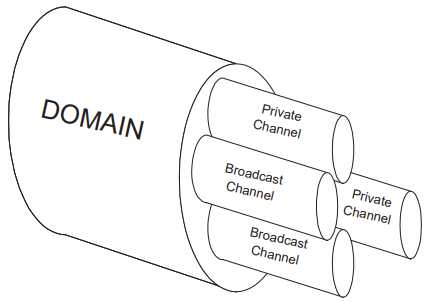
It is the application developer's responsibility to determine how to use channels within an application. For example, an application may send control information along a single channel and application data along a series of channels that may vary depending upon the type of data being sent. The application developer may also take advantage of the MCS concept of private channels to direct data to a discrete subset of a given conference.
Data may be sent with one of four priority levels. MCS applications may also specify that data is routed along the quickest path of delivery using the standard send command. If the application uses the uniform send command, it ensures that data from multiple senders will arrive at all destinations in the same order. Uniform data always travels all the way up the tree to the Top Provider. Table 1 provides an example of how a document conferencing application could set up its channels. Reliable or unreliable data delivery is determined by the application.
| Channel | Type | Priority | Routing |
|---|---|---|---|
| 1 | Error Control Channels | Top | Standard |
| 2 | Annotations | High | Uniform |
| 3 | Bitmap Images | Medium | Uniform |
| 4 | File Transfer | Low | Standard |
There are no constraints on the size of the data sent from an application to MCS. Segmentation of data is automatically per-formed on behalf of the application. However, after receiving the data it is the application's responsibility to reassemble the data by monitoring flags provided when the data is delivered.
Tokens are the last major facility provided by MCS. Services are provided to grab, pass, inhibit, release, and query tokens. Token resources may be used as either exclusive (i.e., locking) or non-exclusive entities.
Tokens can be used by an application in a number of ways. For example, an application may specify that only the holder of a specific token, such as the conductor, may send information in the conference.
Another popular use of tokens is to coordinate tasks within a domain. For example, suppose a teacher wants to be sure that every student in a distance learning session answered a particular question before displaying the answer. Each node in the underlying application inhibits a specific token after receiving the request to answer the question. The token is released by each node when an answer is provided. In the background, the teacher's application continuously polls the state of the token. When all nodes have released the token, the application presents the teacher with a visual cue that the class is ready for the answer.
Generic Conference Control (GCC) - T.124
Generic Conference Control provides a comprehensive set of facilities for establishing and managing the multipoint conference. It is with GCC that we first see features that are specific to the electronic conference.
At the heart of GCC is an important information base about the state of the various conferences it may be servicing. One node, which may be the MCU itself, serves as the Top Provider for GCC information. Any actions or requests from lower GCC nodes ultimately filter up to this Top Provider.
Using mechanisms in GCC, applications create conferences, join conferences, and invite others to conferences. As endpoints join and leave conferences, the information base in GCC is updated and can be used to automatically notify all endpoints when these actions occur. GCC also knows who is the Top Provider for the conference. However, GCC does not contain detailed topology information about the means by which nodes from lower branches are connected to the conference.
Every application in a conference must register its unique application key with GCC. This enables any subsequent joining nodes to find compatible applications. Furthermore, GCC provides robust facilities for applications to exchange capabilities and arbitrate feature sets. In this way, applications from different vendors can readily establish whether or not they can interoperate and at what feature level. This arbitration facility is the mechanism used to ensure backward compatibility between different versions of the same application.
GCC also provides conference security. This allows applications to incorporate password protection or "lock" facilities to prevent uninvited users from joining a conference.
Another key function of GCC is its ability to dynamically track MCS resources. Since multiple applications can use MCS at the same time, applications rely on GCC to prevent conflicts for MCS resources, such as channels and tokens. This ensures that applications do not step on each other by attaching to the same channel or requesting a token already in use by another application.
Finally, GCC provides capabilities for supporting the concept of conductorship in a conference. GCC allows the application to identify the conductor and a means in which to transfer the conductor's "baton." The developer is free to decide how to use these conductorship facilities within the application.
T.124 Revised
As part of the ongoing enhancement process for the T.120 standards, the ITU has completed a draft revision of T.124. The new version, called T.124 Revised, introduces a number of changes to improve scalability. The most significant changes address the need to distribute roster information to all nodes participating in a conference, as well as improvements in the efficiency of sending roster refresh information (from the Top Provider) any time a node joins or leaves a conference.
To improve the distribution of roster information, the concept of Node Categories was introduced. These categories provide a way for a T.124 node to join or leave a conference without affecting the roster information that was distributed throughout a conference. In addition, the Full Roster Refresh, which was previously sent any time a new node joined a conference, was eliminated by sending out roster details from the Top Provder. These changes will not affect backward compatibility to earlier revisions of T.124. This revision will go to the ITU for Decision in March of 1998.
Generic Application Template (GAT) - T.121
T.121 provides a template for T.120 resource management that developers should use as a guide for building application protocols. T.121 is mandatory for standardized application protocols and is highly recommended for non-standard application protocols. The template ensures consistency and reduces the potential for unforeseen interaction between different protocol implementations.
Within the T.121 model, GAT defines a generic Application Resource Manager (ARM). This entity manages GCC and MCS resources on behalf of the application protocol-specific functionality defined as an Application Service Element (ASE). Figure 5 demonstrates the GAT model within the T.120 architecture. Simply put, GAT provides a consistent model for managing T.120 resources required by the application to which the developer adds application-specific functionality.
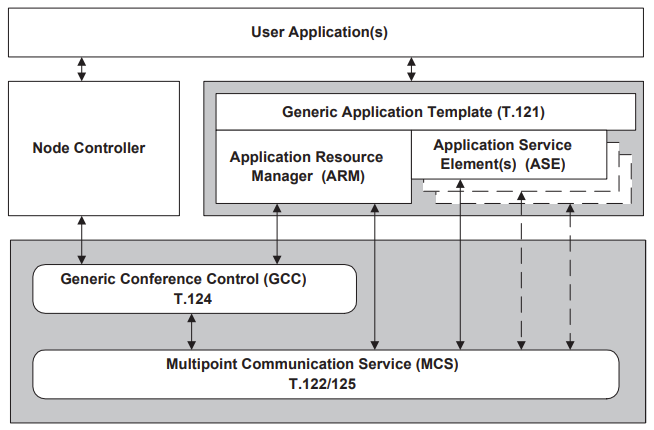
GAT's functionality is considered to be generic and common to all application protocols. GAT's services include enrolling the application in GCC and attaching to MCS domains. GAT also manages channels, tokens, and capabilities on behalf of the application. On a broader scale, GAT responds to GCC indications and can invoke peer applications on other nodes in the conference.
Still Image Exchange and Annotation (SI) - T.126
T.126 defines a protocol for viewing and annotating still images transmitted between two or more applications. This capability is often referred to as document conferencing or shared whiteboarding.
An important benefit of T.126 is that it readily shares visual information between applications that are running on dramatically different platforms. For example, a Windows-based desktop application could easily interoperate with a collaboration program running on a PowerMac. Similarly, a group-oriented conferencing system, without a PC-style interface, could share data with multiple users running common PC desktop software.
As Figure 6 illustrates, T.126 presents the concept of shared virtual workspaces that are manipulated by the endpoint applications. Each workspace may contain a collection of objects that include bitmap images and annotation primitives, such as rectangles and freehand lines. Bitmaps typically originate from application information, such as a word processing document or a presentation slide. Because of their size, bitmaps are often compressed to improve performance over lower-speed communication links.
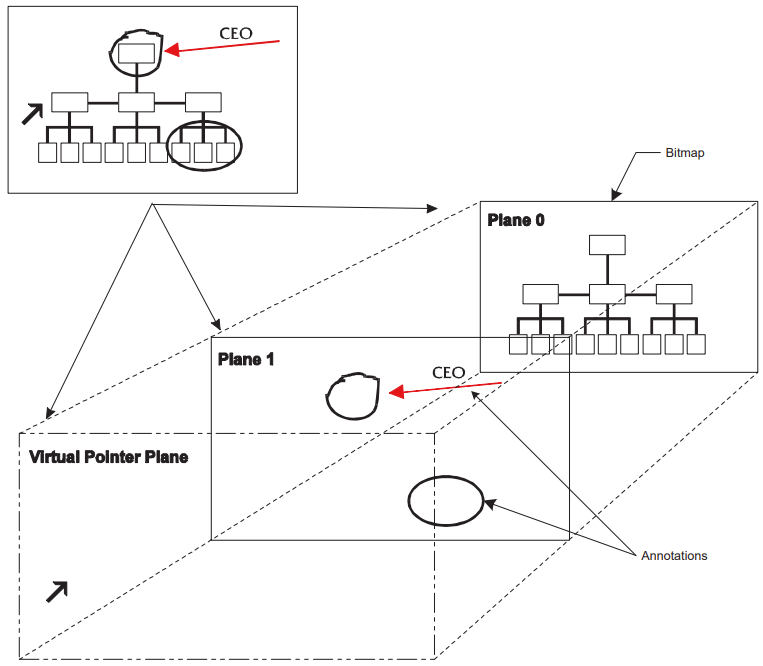
T.126 is designed to provide a minimum set of capabilities required to share information between disparate applications. Because T.126 is simply a protocol, it does not provide any of the API-level structures that allow application developers to easily incorporate shared whiteboarding into an application. These types of facilities can only be found in toolkit-level implementations of the standard (such as DataBeam's Shared Whiteboard Application Toolkit, known as SWAT).
Multipoint Binary File Transfer - T.127
T.127 specifies a means for applications to transmit files between multiple endpoints in a conference. Files can be transferred to all participants in the conference or to a specified subset of the conference. Multiple file transfer operations may occur simultaneously in any given conference and developers can specify priority levels for the file delivery. Finally, T.127 provides options for compressing files before delivering the data. Figure 7 displays a view of conference-wide and individual file transfers.
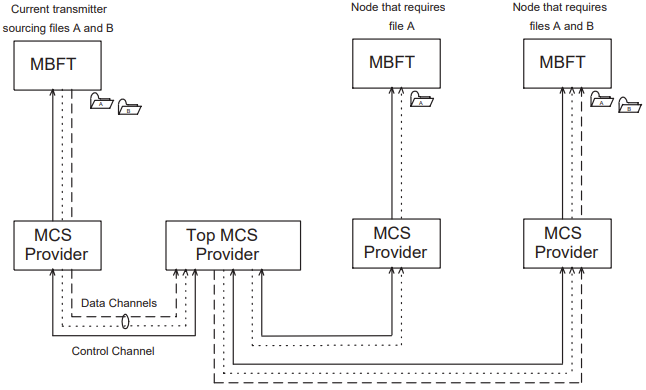
Node Controller
The Node Controller manages defined GCC Service Access Points (SAPs). This provides the node flexibility in responding to GCC events. Most of these GCC events relate to establishing conferences, adding or removing nodes from a conference, and breaking down and distributing information. The Node Controller's primary responsibility is to translate these events and respond appropriately.
Some GCC events can be handled automatically; for example, when a remote party joins a conference, each local Node Controller can post a simple message informing the local user that "Bill Smith has joined the conference." Other events may require user intervention; for example, when a remote party issues an invitation to join a conference, the local Node Controller posts a dialog box stating that "Mary Jones has invited you to the Design Review conference. <Accept> <Decline>."
Node controllers can be MCU-based, terminal-based, or dual-purpose. DataBeam's application, FarSite, for example, contains a dual-purpose Node Controller. The range of functionality found within a Node Controller can vary dramatically by implementation.
Only one Node Controller can exist on an active T.120 endpoint. Therefore, if multiple applications need to simultaneously use T.120 services, the Node Controller needs to be accessible to each application. The local interface to the Node Controller is application- and vendor-specific and is not detailed in the T.120 documentation.
Interoperability
Buyers overwhelmingly rate interoperability as the number one purchase criteria in their evaluation of teleconferencing products. For most end users, interoperability translates to "my application can talk to your application"—regardless of which vendor supplied the product or on what platform it runs. When examining the T.120 standard closely, buyers can see that it provides for two levels of interoperability: application-level interoperability and network-level interoperability.
Network-level Interoperability
Network-level interoperability means that a given product can interwork with like products through the infrastructure of network products and services that support T.120. For example, T.120-based conferencing bridges (MCUs) that can support hundreds of simultaneous users are now being developed. If an application supports only the lower layers of T.120, customers can use these MCUs to host a multipoint conference only if everyone in the conference is using the exact same product. Figure 8 displays network interoperability through a conference of like products.
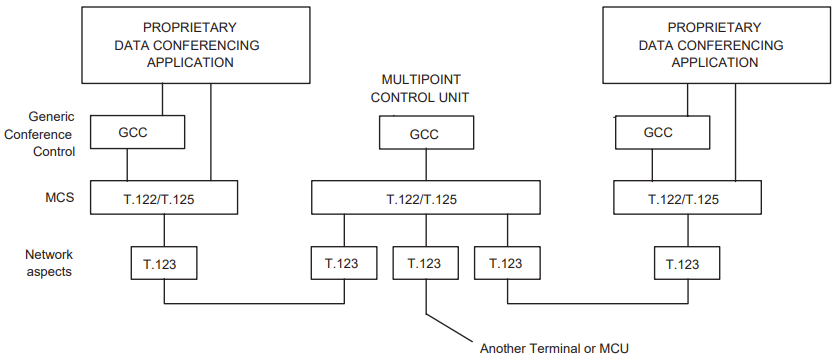
Application-level Interoperability
The upper levels of T.120 specify protocols for common conferencing applications, such as shared whiteboarding and binary file transfer. Applications supporting these protocols can interoperate with any other application that provides similar support, regardless of the vendor or platform used. For example, through T.126, users of DataBeam's FarSite application will be able to share and mark up documents with users of group conferencing systems. This interoperability will exist in simple point-to-point conferences as well as large multipoint conferences using a conference bridge. Figure 9 represents application-level interoperability between two standards-based applications connected in a conference.
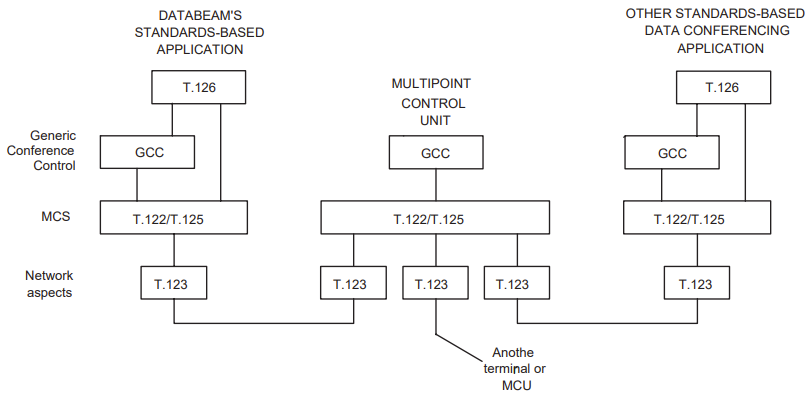
In the short-term, network-level interoperability will be the most common form of T.120 support found in conferencing applications. This is largely due to the fact that the lower-level T.120 layers were ratified by the ITU more than a year in advance of the application-level layers. However, end users will not be satisfied with network interoperability alone. For the market to grow, vendors will have to deliver the same application-level interoperability (or endpoint interoperability) that customers enjoy today with fax machines and telephones.
Ratification of the T.120 and Future T.130 Standards
The Recommendations for the core multipoint communications infrastructure components (T.122, T.123, T.124 and T.125) were ratified by the ITU between March of 1993 and March of 1995. The first of the application standards (T.126 and T.127) was approved in March of 1995. An overview of the T.120 series was approved in February of 1996 as Recommendation T.120. T.121 (GAT) was also approved at that time. Stable drafts of these recommendations existed for some time prior to the ratification, thereby providing a means for DataBeam to actively develop products in parallel to the standardization effort.
The existing ratified standards are being actively discussed for possible amendments and extensions. This commonly occurs when implementation and interoperability issues arise.
T.130 Audio-visual Control For Multimedia Conferencing
The T.130 series of recommendations define an architecture, a management and control protocol, and a set of services which together make up an Audio-Visual Control system (AVC). This system supports the use of real-time streams and services in a multimedia conferencing environment. The protocol and services section, outlined in T.132, consists of two parts: management and control. Together, they allow Network Elements, such as the traditional MCU, Gateway, or Conference Server, to provide T.132 audio and video services to their endpoints. Some of the services include Stream Identification, On-Air Identification, Video Switching, Audio Mixing, Remote Device Control, and Continuous Presence.
The T.130 series is built upon existing ITU-T conferencing recommendations such as the H.320 audio-visual conferencing series and the T.120 series for multipoint data conferencing. The T.130 series is compatible with systems, such as H.323, in which audio and video are transmitted independently of T.120, as well as systems which are capable of transmitting multiple media types within a common multiplex.
Unlike other standardized methods for managing real-time streams within a conference, T.130 provides some unique capabilities:
- Contains a network- and platform-independent control protocol for managing real-time streams
- Coordinates operations across network boundaries
- Processes and distributes media streams within a conference environment
- Delivers of Quality of Service (QoS) to multimediacommunications applications
- Provides distributed conference management
- Leverages the functionality of existing multimedia protocols
T.130 can be used in any conferencing scenario where there is a need for multipoint audio or video. T.130 relies upon the services of GCC and MCS to transmit control data, but the audio and video streams are transported in independent logical channels due to the transmission requirements of real-time data flows. (See Figure 10).
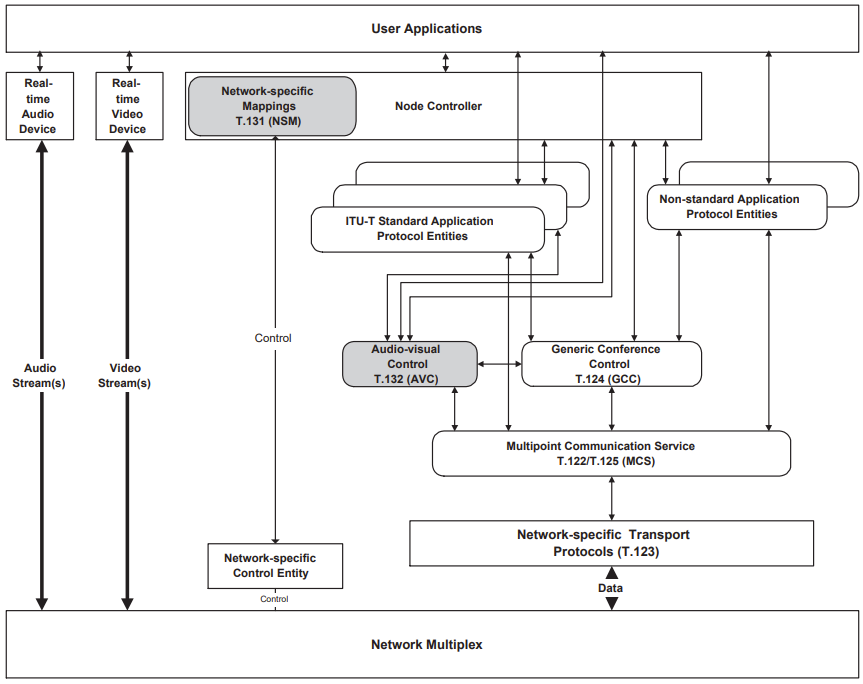
T.130 and T.132 were determined in March of 1997 and should be ratified in January of 1998. T.131, which defines network-specific mappings to allow AVC to communicate with the underlying Multimedia Control Protocol, such as H.245, should be determined in the Fall of 1997.
Vendor Community Support for T.120
More than 100 multi-national companies have pledged their support for the T.120 standard and more are being added to this list every week. Public supporters of T.120 include international market leaders such as Apple, AT&T, British Telecom, Cisco Systems, Deutsche Telecom, IBM, Intel, MCI, Microsoft, Motorola, PictureTel, and DataBeam.
Most supporters of T.120 are also members of the International Multimedia Teleconferencing Consortium (IMTC). The goals of the IMTC are to promote the awareness and adoption of ITU teleconferencing standards, including T.120 and H.32x. The IMTC provides a forum for interoperability testing and helps to define Application Programming Interfaces (APIs). DataBeam's co-founder and chief technical officer, C. J. "Neil" Starkey, serves as the president of the IMTC. Previously, Starkey served for six years as chairman of the ITU study group that defined T.120.
New Markets for T.120 Deployment
The teleconferencing community is the first market segment to adopt the T.120 standard. Because the technology is broad in scope, it can be effectively used by a number of other application software vendors and equipment providers.
The computing paradigm is rapidly extending past today's personal productivity model. Over the next two years, we will witness the development of a new generation of application software that incorporates multi-party collaboration. Independent Software Vendors (ISVs) have begun to adopt T.120 as the means in which to incorporate real-time collaboration capabilities into common desktop applications, such as word processing and presentation graphics. Engineering products, such as Computer Aided Design (CAD) software, are also on the migration path to T.120 technology. Other ISVs with a strong interest in T.120 include developers of fax, remote control, document imaging, and "overtime" collaboration products, such as Lotus Notes.
With T.120 technology in the hands of operating system providers and horizontal application vendors, network equipment providers are beginning to take notice. For vendors of PBXs, network bridges, hubs, routers and switches, T.120 represents an important opportunity to provide value-added capabilities within their network products. In the short-term, these features will represent an opportunity for competitive advantage. However, within the next year, T.120 support will be a required feature.
Finally, we can envision a whole range of T.120 applications in the areas of interactive video, network gaming, and simulations. From Nintendo to DOOM to set-top boxes, the need for bidirectional multipoint data communications is acute. The ability to use a common set of APIs and protocols that are broadly supported from the desktop through the network will drive the adoption of T.120 into these important emerging markets.
IMTC, ITU, and T.120
Standards have played an important part in the establishment and growth of several consumer and telecommunications markets. By creating a basic commonality, standards ensure compatibility among products from different manufacturers. This encourages companies to produce varying solutions and encourages end users to purchase the solutions without fear of obsolescence or incompatibility.
The work of both the IMTC and the ITU represents organized efforts to promote a basic connectivity protocol that will encourage the growth of the multimedia telecommunications market. The Standards FirstTM initiative, which is supported by many industry leaders, requires a minimum of H.320 and T.120 compliance, which is enough to establish this basic connectivityprotocol. Manufacturers are then able to build on the basic compliance by adding features to their products, creating Standards Plus equipment.
With Standards First, the IMTC has the end users' interests in mind. By ensuring interoperability among equipment from competing manufacturers, Standards First also ensures that a customer's initial investment is protected and future system upgrades are possible. The IMTC is helping to educate the industry and the public about the importance, function, and status of standards. In addition, the organization provides a coordination point for industry leaders to communicate their interests to the ITU-T. As the multipoint multimedia teleconferencing industry continues its rapid growth, the development and implementation of standards for interoperability, and the work of the IMTC, will be instrumental in securing the market's future.
Implementing T.120
With the T.120 set of standards in place, third-party developers are faced with yet another challenge- implementation. DataBeam's Collaborative Computing Toolkit Series (CCTSTM) has jump-started the conferencing industry by providing the first standards-based toolkits for developing multipoint, data-sharing applications. These toolkits encapsulate the complex system-wide, multipoint communications stacks that allow application developers to rapidly embed sophisticated real-time, data-sharing capabilities into new or existing products. Simply stated, CCTS provides a seamless solution for parties developing standards-based communication solutions.
As a result, DataBeam envisions an acceleration in the development of software applications and network infrastructure products such as, PBXs, bridges, routers, network switches, and LAN servers, that incorporate T.120. In addition, the industry will grow well beyond today's existing paradigms and the world will begin to see a whole range of new products and services that incorporate T.120. Users waiting for the standards dust to settle can now feel confident that with the support of vendors like Microsoft, DataBeam's T.120-based Collaborative Computing Toolkit Series is the best solution for industry-wide interoperability.
This document is copyright © 1997 by DataBeam Corporation and is reproduced with permission.
